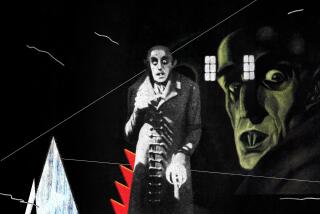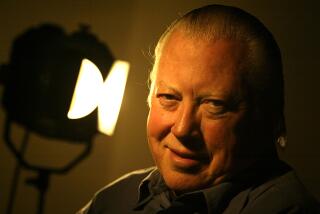Scott Frank and Steven Soderbergh bring a shoot-’em-up to Netflix with ‘Godless’
Reporting from New York — Screenwriter Scott Frank got an itchy trigger finger nearly two decades ago: he wanted to make a western.
“I feel like no self-respecting screenwriter can get to the end of their careers without having at least tried it,” Frank, 57, who was nominated for an Oscar for Steven Soderbergh’s 1998 film “Out of Sight,” recently explained over a late lunch in the West Village.
The result is “Godless.” Originally planned as a feature, the seven-episode miniseries arrives Wednesday on Netflix after more twists and turns than a rerouted stagecoach. The saga is the first limited series originally commissioned for Netflix and, with its sweeping vistas and deliberate pacing, also represents the latest small-screen effort at the kind of old-fashioned storytelling the major studios have all but abandoned.
Written and directed by Frank and executive produced by Soderbergh and Casey Silver, the widescreen epic is set in the 1880s in La Belle, N.M., a dusty frontier town run by women — not out of some utopian ideal but because a catastrophic mining accident has wiped out nearly the entire male population.
Town outcast Alice Fletcher (Michelle Dockery) has given refuge to Roy Goode (Jack O’Connell), an outlaw on the run from merciless gang leader Frank Griffin (Jeff Daniels), setting up an inevitable showdown between Griffin’s henchmen and the gun-toting women of La Belle.
“Godless” has its roots in “Out of Sight,” the sophisticated Elmore Leonard adaptation that would probably have a hard time getting greenlighted today, given its lack of superheroes or franchise potential. In addition to Frank’s Oscar nomination, the George Clooney-Jennifer Lopez thriller helped revive Soderbergh’s directing career and marked the beginning of a friendship between the two filmmakers.
Soderbergh describes that film as “a watershed project for me both creatively and professionally” and fondly recalls the three weeks he and Frank, whose screenwriting credits also include “Get Shorty” and “Minority Report,” spent working on the shooting draft for “Out of Sight.”
Sometime around 2000, Frank floated the idea of a western to producer Silver, who’d shepherded “Out of Sight” as chairman of Universal Pictures, with the vague idea it might be something for Soderbergh to direct.
“It was a sentence over lunch and it was the person who was delivering the sentence that made it intriguing,” says Silver, who praises Frank’s ability to craft “genre pieces that are recognizable, even as they’re highly original.”
Frank began a year-long process of research, reading and watching all the westerns he could get his hands on, in part just to train his ear. “I didn’t want a movie full of ‘I reckon we should rustle up a bunch o’ grub.’” He also wanted to find a new way into the genre while embracing all its tropes — the gunfights, the train robberies, the father-son conflicts.
Inspired by Wallace Stegner’s novel “Angle of Repose” and Robert Altman’s film “McCabe & Mrs. Miller,” he gradually focused on mining as a jumping-off point. His researcher, Mimi Munson, came across reports in the Old West of mining accidents in places like Crested Butte, Colo., and Dawson, N.M. that killed dozens of men.
Said Frank: “The women would be stranded in these places. Sometimes they’d move on and sometimes they’d make a go of it. And I thought there’s my idea.” His goal was not to necessarily write a feminist western, but to craft a “rip-roaring yarn” of “people who are living lives they never planned on living.”
He approached Soderbergh about the project after the success of “Ocean’s Eleven” and “Erin Brockovich” made Soderbergh one of Hollywood’s most bankable filmmakers.
The director loved the script, which he described as “a completely revisionist western in a classic form,” but there was just one problem: he’s terrified of horses.
“They’re really, really large and strong and they know I don’t like them,” Soderbergh said.
“I remember thinking, maybe I should have asked him that before I started writing,” Frank recalled with a wry laugh.
As he and Silver continued to pitch “Godless” around town, Frank branched out into directing with the 2007 noir “The Lookout” and Liam Neeson in “A Walk Among the Tombstones” He decided he wanted to helm “Godless,” which was already a tough sell, thanks to the feeble international market for westerns and a projected running time of three hours.
“Years would go by of it almost getting made and people would say, ‘I like the script, I hope someone else makes it,’ over and over,” said Frank.
Soderbergh, who’d moved into directing on the small screen with “The Knick” and “Behind the Candelabra” after growing disillusioned with the film business, eventually suggested dusting off the script and refashioning it for television as a limited series: “I said, ‘Instead of trying to figure out how to hack limbs off this thing, why don’t you add some limbs? Make it six hours instead of three.”
The team brought the project to Netflix, and vice president of original content Cindy Holland, who had been keen to develop a western, quickly greenlighted the project, rescuing “Godless” after a decade-plus in purgatory.
With just a few months to turn around scripts before production was set to begin in New Mexico, Frank focused on expanding elements of the story, including the character Mary Agnes (Merritt Wever), a woman who’s swapped her corset for a pair of trousers, fallen in love with the town prostitute and is liberated by her new circumstances. Wever, an Emmy winner from “Nurse Jackie,” was equally excited by a part that didn’t fit any conventional boxes: “If they didn’t write roles like this, I wouldn’t work.”
In the middle of a cultural reckoning about gender inequality, “Godless” is likely to resonate, but Frank is reluctant to play up the show’s contemporary relevance:. “I’m too imperfect to be a spokesperson for anybody.”
Soderbergh stayed far away from the horse-heavy set during the show’s six-month production, but remained involved as a kind of “consigliere,” watching dailies and sharing hard-earned wisdom from his experience directing “The Knick.” )
He was also deeply invested in the editing process, during which “Godless” was reshaped from six to seven episodes — some as long as 85 minutes in length. Frank was committed to maintaining the story’s unhurried rhythm even if, as he joked, he made a few “ex-friends” by hosting marathon nine-hour-plus test screenings.
He remembered advice given to him by director Lawrence Kasdan (“Wyatt Earp”) about making westerns: “Everything is going to take longer on the screen than it does on the page by a lot.”
It can also take a while to get there.
See the most-read stories in Entertainment this hour »
Follow me @MeredithBlake
More to Read
The complete guide to home viewing
Get Screen Gab for everything about the TV shows and streaming movies everyone’s talking about.
You may occasionally receive promotional content from the Los Angeles Times.






